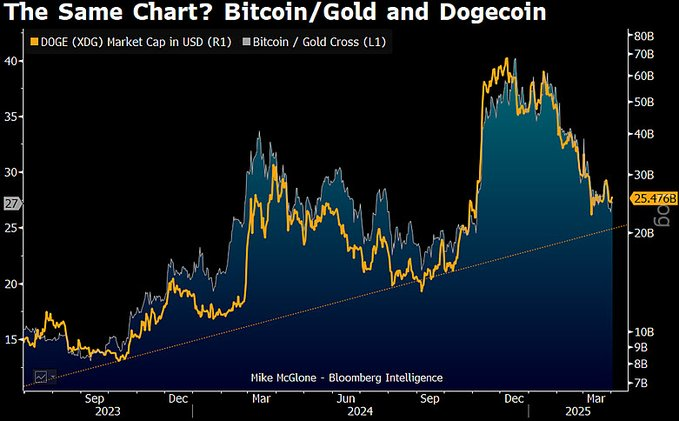Is Dogecoin hinting at U.S. economy’s next move? Strategist breaks it down
Is Dogecoin hinting at U.S. economy’s next move? Strategist breaks it down 
![]() Cryptocurrency Apr 2, 2025 Share
Cryptocurrency Apr 2, 2025 Share
A commodity strategist has observed that meme cryptocurrency Dogecoin’s (DOGE) market trends could be mirroring larger economic shifts, particularly those influenced by trade policies.
In this line, Bloomberg Intelligence’s Mike McGlone noted that comparing DOGE’s market cap to Bitcoin’s (BTC) price relative to gold raises questions about whether speculative assets are foreshadowing macroeconomic trends, he said in an X post on April 3.
McGlone highlighted what he termed as “Same-Chart Syndrome,” where Bitcoin and Dogecoin move in tandem, suggesting speculative assets react similarly to economic pressures.
Picks for you
Here’s how much Trump’s Presidency has cost Elon Musk so far 5 hours ago Will 'Liberation Day' tariffs send XRP below $2? 5 hours ago AI predicts XRP price for April 30, 2025 6 hours ago Is Bitcoin dead? Crypto fund founder slams BTC as ‘out-of-date' 9 hours ago
He pointed out that Bitcoin’s price relative to gold mirrors Dogecoin’s market cap, indicating shared cycles of speculation and contraction.
 Bitcoin, gold, and Dogecoin market cap chart. Source: Bloomberg Intelligence
Bitcoin, gold, and Dogecoin market cap chart. Source: Bloomberg Intelligence
Drawing a parallel to the U.S. economy, the expert suggested that proposed tariffs shrinking a $1.2 trillion trade deficit could create volatility for dependent exporters, much like speculative assets.
“The joke Dogecoin is just one. US tariffs to reduce it’s about $1.2 trillion trade deficit (past 12 months) could have similar inklings to dependent exporters,” he said.
Notably, Bitcoin and Dogecoin have seen sharp price volatility amid economic uncertainty from President Donald Trump’s trade tariffs, with more set for April 2. Consequently, investors seeking stability have driven gold to a record high above $3,000.
Impact of Trump’s policies on risk assets
McGlone had previously warned that President Trump’s economic policies are attempting to reset the post-World War II global order, in which many countries built net export surpluses with the United States.
Now, if the world’s largest economy shifts toward protectionist trade policies, risk assets may be the first to feel the impact, leading to increased volatility, particularly in cryptocurrencies.
According to the strategist, such a shift could mean downward pressure on stocks and continued dominance of highly speculative assets.
Trump is resetting the post WWII order of most of the world running net export surpluses with the US. What does it mean for risk assets? Down for the US and highly speculative and volatile #cryptocurrencies are likely to continue leading the way. #Gold $3,000 an ounce resistance… https://t.co/VrUNXBt3a9
— Mike McGlone (@mikemcglone11) April 2, 2025
To this end, digital assets with minimal use cases, such as meme-inspired ones like Dogecoin, might be the first to react to shifting capital flows.
In the same analysis, McGlone noted that gold’s historic $3,000-per-ounce resistance level may now be transitioning into a long-term support level.
Therefore, such a price movement might signal a growing flight to safety as investors seek stability amid economic turbulence. As reported by Finbold, McGlone projected that falling risk asset prices are a catalyst likely to help the precious metal target $4,000.
Featured image via Shutterstock

